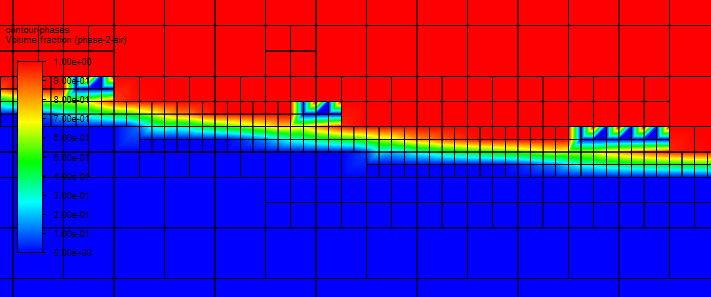TAGGED: 2D, ansys-fluent, meshing, multiphase, transient
-
-
May 11, 2021 at 1:59 pm
hugojl
SubscriberI am simulating a 2D bubble of air rising through water using Fluent. To properly resolve the interface without excessive computational cost I would like to use adative mesh refinement. I use cell registers to select cells with large (>0.05) volume fraction gradients and refine those, while those with low/no volume fraction gradients (<0.005) are coarsened. However, during the refining (and coarsening) operation near the interface, pockets of the wrong phase are inserted. Over time, this leads to deformation of the interface.
I attempted to use additional refinement layers to stop the mesh from being changed too close to the interface, but this does not seem to work in conjunction with AMR: The cells are coarsened anyway. Using the volume fraction itself or the curvature instead of the gradient for refinement/coarsening, or changing the numbers used as criteria, also does not work. Part of the problem seems to be recognising which cells should be refined; the cells affected by these pockets are not recognised by the cell register as containing a volume fraction gradient, nor a significant water fraction (I have remeshing on for every time step in this test). However, they are not artifacts, as they grow over time and deform the interface (see second picture).
Is there a way to fix this? Can the coarsening criterion be applied only a certain distance away from the interface? How does the AMR algorithm decide what phase to use for the new cell(s) if not by interpolating across the old cell(s)?
May 11, 2021 at 3:35 pmRob
Forum ModeratorInterface anti-diffusion in the VOF panel helps. I tend to refine/coarsen based on volume fraction rather than gradient because of the way VOF works. The cells are filled based on an interpolation of what was there before the refinement/coarsening occurred. Which VOF scheme are you using (compressive or geo-reconstruct)?
May 13, 2021 at 2:01 pmhugojl
SubscriberHi Rob, I am using the Geo-Reconstruct scheme, as I plan on incorporating mass transfer and I read that PLIC is preferred for that. Apologies for the slow reply, I wanted to test the different interface schemes with and without anti-diffusion. I have now tested the four available by default (Geo-Reconstruct, CICSAM, Compressive and HRIC) with and without anti-diffusion, but they all give similar results. This also occurs when I refine based on volume fraction itself. I thought overly lax convergence controls might be to blame, but sharpening the criteria doesn't reduce the phenomenon. The only thing I've found prevents the problem is fewer refinement levels. Do you know if I can prevent coarsening within a certain distance of the interface?
May 13, 2021 at 3:20 pmRob
Forum ModeratorGeo-recon should be the most accurate, but will cost you in time step size: check it's converging for every time step. Can you replot with node values off? The interpolation for graphics smoothing may be getting confused: the VOF model shouldn't give a result like that.
Also try using the built in VOF refinement & coarsening: we tend to use VOF values over gradients to refine the free surface.
May 18, 2021 at 12:57 pmhugojl
SubscriberSwitching node values off fixed the breakup issue. There is still deformation, but that is a different problem. Thank you very much!
Viewing 4 reply threads- The topic ‘How do I stop pockets of the wrong phase being created by AMR?’ is closed to new replies.
Ansys Innovation SpaceTrending discussionsTop Contributors-
3767
-
1333
-
1173
-
1090
-
1014
Top Rated Tags© 2025 Copyright ANSYS, Inc. All rights reserved.
Ansys does not support the usage of unauthorized Ansys software. Please visit www.ansys.com to obtain an official distribution.
-












